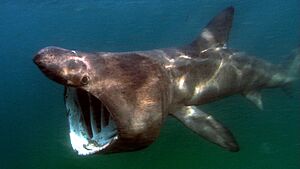Cetorhinidae facts for kids
Quick facts for kids Cetorhinidae |
|
|---|---|
 |
|
| Cetorhinus maximus | |
| Scientific classification |
|
| Unrecognized taxon (fix): | Cetorhinidae |
| Genera | |
|
|
| Synonyms | |
|
|
The Cetorhinidae family is home to some truly amazing ocean creatures, most famously the basking shark. These incredible sharks are known as "filter feeders" because they eat tiny plants and animals from the water, rather than hunting large prey. Imagine a giant vacuum cleaner of the sea! This family includes the basking shark we see today, called Cetorhinus, and also some ancient shark relatives that are now extinct, like Caucasochasma and Keasius.
Contents
Basking Sharks: Gentle Giants of the Ocean
Basking sharks are the second-largest fish in the world, right after the whale shark. Despite their enormous size, they are completely harmless to humans. They get their name "basking" because they often swim slowly near the surface of the water, looking like they are enjoying the sun.
What Are Basking Sharks?
Basking sharks belong to a group called mackerel sharks, which also includes famous hunters like the great white shark. However, basking sharks are very different. Instead of sharp teeth for hunting, they have special structures in their mouths called gill rakers. These rakers help them filter their food from the ocean water.
Where Do Basking Sharks Live?
These gentle giants live in oceans all around the world. They prefer temperate waters, which means areas that are not too hot and not too cold. You can find them in the Atlantic, Pacific, and Indian Oceans. They often travel long distances, sometimes migrating thousands of kilometers to find the best feeding grounds.
What Do Basking Sharks Eat?
Basking sharks are "filter feeders." This means they swim with their huge mouths wide open, scooping up enormous amounts of seawater. As the water passes over their gills, the gill rakers trap tiny organisms like plankton and small fish. They can filter thousands of liters of water every hour! It's like they have a giant sieve in their mouths.
How Big Can Basking Sharks Get?
An adult basking shark can grow to be very long, sometimes reaching up to 12 meters (about 40 feet) in length. That's longer than a school bus! They can also weigh several tons. Imagine seeing a creature that big swimming gracefully through the water.
The Basking Shark Family Tree
The Cetorhinidae family has been around for a very long time. Scientists have found fossils of these sharks dating back to the Middle Eocene epoch, which was about 41.2 million years ago. This means they have been swimming in Earth's oceans for millions of years!
Ancient Relatives: Extinct Sharks
Besides the modern basking shark (Cetorhinus), the Cetorhinidae family also includes two extinct genera: Caucasochasma and Keasius. These ancient sharks are known only from their fossilized remains, mostly teeth. Studying these fossils helps scientists understand how basking sharks have evolved over millions of years. It's like looking at old family photos to see how your relatives have changed!
Protecting Basking Sharks
Sadly, basking sharks face several threats today. Historically, they were hunted for their liver oil, meat, and fins. While hunting has largely stopped in many areas, they can still get caught accidentally in fishing nets. Because they reproduce slowly, their populations can take a long time to recover. Many countries and international organizations are working to protect basking sharks and ensure they continue to thrive in our oceans. It's important for us to learn about and protect these magnificent creatures.

